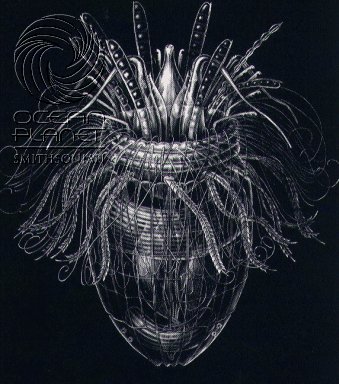- Loricifera
Taxobox
name = Loricifera

image_width = 200px
image_caption = "Pliciloricus enigmatus "
regnum =Animal ia
phylum = Loricifera
phylum_authority = Kristensen, 1983
subdivision_ranks = Genera
subdivision = "Nanaloricus " "Armorloricus " "Phoeniciloricus " "Pliciloricus " "Rugiloricus " "Spinoloricus " "Titaniloricus "Loricifera (from
Latin , "lorica",corselet + Greek, φορη, "phora", bearing) is a smallphylum of marine sediment-dwelling animals with twenty-two described species, in eight genera.Gad, G. 2005. Successive reduction of the last instar larva of Loricifera, as evidenced by two new species of Pliciloricus from the Great Meteor Seamount (Atlantic Ocean). Zoologischer Anzeiger. 243: 239-271.] Ruppert, Edward E., Richard S. Fox, and Robert D. Barnes. Invertebrate Zoology. 7th ed. Toronto: Brooks/Cole - Thomson Learning, 2004. 776.] Aside from these described species, there are approximately 100 more which have been collected and not yet described. They are characterised by a protective outer case called a lorica and their habitat, which is in the spaces between marine gravel to which they attach themselves. The phylum was discovered in 1983 byReinhardt Kristensen , in Roscoff, France.Heiner, I., Kristensen, R.H. 2005. Two new species of the genus Pliciloricus (Loricifera, Pliciloricidae) from the Faroe Bank, North Atlantic. Zoologischer Anzeiger. 243: 121-138.] They are among the very latest of discovered groups ofMetazoan s.Kristensen, R.M. 2002. An Introduction to Loricifera, Cycliophora, and Micrognathozoa. Integrative and Comparative Biology. 42: 641-651.] They attach themselves quite firmly to the substratum, and so remained undiscovered for so long. The first specimen was collected in the 1970s, and later described in 1983. They are found at all depths, in different sediment types, and in all latitudes.The animals have a head, mouth and digestive system as well as a lorica. The armor-like lorica consists of a protective external shell or case of encircling plicae. There is no circulatory system and no endocrine system. Many of the larvae are
acoelomate , with some adults beingpseudocoelomate , and some remaining acoelomate. The animals arehermaphrodite s and probablyoviparous . They have a very complex life cycle. The species which live in the deep sea are able to reproduce via parthenogenetic or paedogenetic reproduction. They are not known to be present in the fossil record.Their closest relatives are thought to be the
Kinorhyncha andPriapulida with which they constitute the taxonScalidophora . The three phyla share four characters in common – chitinous cuticle, rings ofscalid s on the introvert, flosculi, and two rings of introvert retracts. A group calledIntroverta is formed with Kinorhyncha, Priapulida,Nematoda , andNematomorpha .References
Wikimedia Foundation. 2010.
